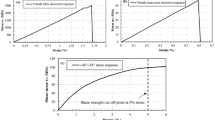Abstract
A simple analytical impact damage model for preliminary design analysis is developed on the basis of experimental findings observed from quasi-static lateral load and low velocity impact tests. The analytical model uses a non-linear approximation method (Rayleigh–Ritz) and the large deflection plate theory to predict the number of failed plies and damage area in a quasi-isotropic composite circular plate (axisymmetric problem) due to a point load at its centre. It is assumed that the deformation due to a static transverse load is similar to that occurred in a low velocity impact. It is found that the model, despite its simplicity, is in good agreement with finite element (FE) predictions and experimental data for the deflection of the composite plate and gives a good estimate of the number of failed plies due to fibre breakage. The predicted damage zone could be used with a fracture model developed by the second investigator to estimate the compression after impact strength of such laminates. This approach could save significant running time when compared to FE numerical solutions.
Similar content being viewed by others
References
Whitehead, R. S., in ICAF National Review, Pisa, 1985, pp. 10–26.
Greszczuck, L. B., ‘Damage in Composite Panels due to Low Velocity Impact’, in Impact Dynamics, Z. A. Zukas (ed.), Wiley, 1982.
Liu, D., ‘Impact-Induced Delamination – a View of Bending Stiffness Mismatching’, Journal of Composite Materials 22(July), 1988, 674–692.
Fuoss, E., Straznicky, P. V. and Poon, C., ‘Prediction of Impact – Induced Delamination in Composite Plates’, Advanced Composite Letters 3(3), 1994, 193–196.
Murri, G. B. and Guynn, E. G., ‘Analysis of Delamination Growth from Matrix Cracks in Laminates Subjected to Bending Loads’, in Composite Materials: Testing and Design (Eighth Conference), ASTM STP 972, 1988, pp. 322–339.
Suemasu, H. and Majima, O., ‘Multiple Delaminations and Their Severity in Circular Axisymmetric Plates Subjected to Transverse Loading’, Journal of Composite Materials 30(4), 1996, 441–453.
Suemasu, H. and Majima, O., ‘Multiple Delaminations and Their Severity in Non-linear Circular Plates Subjected to Concentrated Loading’, Journal of Composite Materials 32(2), 1998, 123–140.
Fuoss, E., Straznicky, P. V. and Poon, C., ‘Effects of Stacking Sequence on the Impact Resistance in Composite Laminates. Part 2: Prediction Method’, Composite Structures 41(2), 1998, 177–186.
Soutis, C. and Fleck, N. A., ‘Static Compression Failure of Carbon Fibre T800/924C Composite Plate with a Single Hole’, Journal of Composite Materials 24(May), 1990, 536–558.
Sjobolm, P. O., Hartness, J. T. and Cordell, T. M., ‘On Low Velocity Impact Testing of Composite Materials’, Journal of Composite Materials 22(January), 1988, 30–52.
Lee, S. R. and Sun, C. T., ‘On the Apparent Bending Isotropy in Clamped Elliptic Composite Laminates’, Journal of Composite Materials 29(12), 1995, 1601–1620.
Timoshenko and Woinowsky-Krieger, Theory of Plates and Shells, McGraw-Hill, 2nd edn, 1959.
Monagan, M. B., Maple 6: Programming Guide, Waterloo Maple, Waterloo, Ontario, 2000.
Hitchings, D., FE77 User Manual Version 2.49, Imperial College, Aeronautics, 1995.
Khoo, S. W., Low Velocity Impact of Composite Structures, Phd Thesis, University of London, December 1991.
Watson, S. A., The Modelling of Impact Damage in Kevlar-Reinforced Epoxy Composite Structures, PhD Thesis, University of London, November 1994.
Chang, F. K. and Chang, K. Y., ‘A Progressive Damage Model for Laminated Composites Containing Stress Concentrations’, Journal of Composite Materials 21(September), 1987, 834–854.
Lee, J., Compressive Behaviour of Composite Laminates before and after Low Velocity Impact, PhD Thesis, Imperial College London, UK, 2003.
Davies, G. A. O. and Zhang, X., ‘Impact Damage Prediction in Carbon Composite Structures’, International Journal of Impact Engineering 16(1), 1995, 149–170.
Liou, W. J., Tseng, C. I. and Chao, L. P., ‘Stress Analysis of Laminated E-glass Epoxy Composite Plates Subject to Impact Dynamic Loading’, Computers and Structures 61(1), 1996, 1–11.
Highsmith, A. L. and Reifsnider, K. L., ‘Stiffness Reduction Mechanisms in Composite Laminates’, in ASTM STP 775, 1982, pp. 103–117.
Soutis, C. and Curtis, P. T., Prediction of the Post-Impact Compressive Strength of CFRP Laminated Composites, DRA/SMC Technical Report 951012, November 1995.
Author information
Authors and Affiliations
Additional information
Corresponding author.
Rights and permissions
About this article
Cite this article
Lee, J., Soutis, C. Prediction of Impact-Induced Fibre Damage in Circular Composite Plates. Appl Compos Mater 12, 109–131 (2005). https://doi.org/10.1007/s10443-004-7767-8
Received:
Accepted:
Issue Date:
DOI: https://doi.org/10.1007/s10443-004-7767-8




